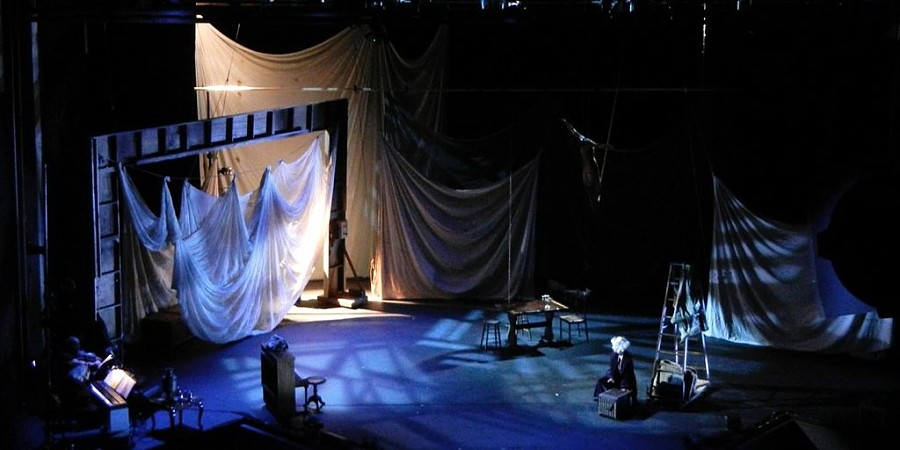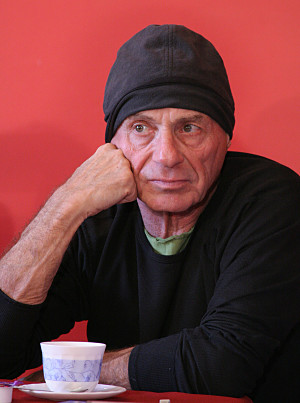Homecomings rarely happen in the theatre world, especially after an four-year-plus hiatus. But this fall Mabou Mines defies the odds: The venerable theatre company returns to its longtime home base, a space, now renovated and expanded, in the East Village of Manhattan’s cultural hub, 122 Community Center (122CC).
How does an avant-garde theatre company survive such a long slumber? The transitory nature of work in the theatre requires constant movement and reinvention that often contradicts the togetherness an arts collective requires. Typically, when member artists split to pursue other creative endeavors, the collective collapses. Not so with Mabou Mines. Company members are welcome to come and go as they please, working with other theatre groups or outside the arts altogether. The difference is that a Mabou Mines artist always comes back.
With almost 50 years of history under its belt, the company has capitalized on the resilience of its members, and artists from all epochs return to Mabou Mines—even after long absences.
Perhaps what makes Mabou Mines so alluring is its radically innovative method of collaboration. Here theatre artists must be jacks-of-all-trades. There are no defined roles; the means of production are consciously undefined to facilitate teamwork. Everyone has a voice in the room. Accordingly, Mabou Mines members are actor-electricians, producer-designers, director-administrators, and every other possible variation of slash-artistry that’s now commonplace in the ragtag world of experimental theatre.
Mabou Mines championed that ethos, and is just now beginning to reap its rewards.

Walking through the company’s new space with co-artistic director Sharon Fogarty, there’s an obvious frenetic energy driving the staff’s work. The offices—in a once-abandoned school building, transformed in 1980 into a performance and arts-residency venue known for more than three decades as Performance Space 122—are still sooty with drywall dust. Cables and stage equipment sit patiently, but everyone is a little anxious: After nearly five years, Mabou Mines is preparing at long last to move back in. The dust has barely settled, but Fogarty and crew are already alight with ideas about how to best use their slightly expanded assets (about 300 square feet more than previously). Occupying the second floor of 122CC, the Mabou Mines hub includes a 99-seat theatre, administrative offices, and rehearsal space. And, thanks to a sizable grant from New York’s City Council, Department of Cultural Affairs, and the Borough President’s Office, Mabou Mines also had the chance to loot the equipment store, purchasing high-tech lighting, sound, and projection equipment totaling over $500,000.
“Receiving that grant from the city…it feels like a vote of confidence,” Fogarty affirms. “It feels like we have achieved recognition for nearly five decades of work, and it’s a promise that we’ll be around for many more years to come.”

But things were not always so high and dry at Mabou Mines; solvency is a relatively new luxury for the company. In a 1996 BOMB Magazine interview, Lee Breuer—Mabou Mines’s co-founder, visionary leader, and boldest artistic instigator—predicted his company’s days were numbered: “We don’t have any money to keep the studio rent paid, or to keep the phones hooked up, or to pay the taxes.” That all changed when Fogarty joined the company as an artistic director in 1999, helping its staff balance the books. And, despite the company’s current windfall, Fogarty’s thrifty attitude remains the staff’s modus operandi. Nothing should be bought unless absolutely necessary; recycling is preferable when possible. For example, one of Mabou Mines’s tech members once welded a mobile light-rigging system out of plumbing pipes to avoid buying a custom piece that would have cost the company thousands of dollars.
“Our theory on how to last as a theatre company is to be like an accordion,” suggested Breuer in a phone call last October. “When there is no air, you contract and go into an aesthetic hibernation. When there is air to breathe, you expand and produce art. We have been on tour for so long—and we began performing in art galleries. Knowing we will now have our own devoted theatre space to play with is important. We can really start exploring.”
Such stability breeds an ambition of unprecedented proportions within the ephemeral world of experimental theatre: Mabou Mines wants to be a company that lasts forever. It makes sense, then, that the company’s recent production Imagining the Imaginary Invalid focused on another theatre company’s ongoing legacy—La Comédie-Française, now going on its 337th year. Molière founded the famous French theatre company as a home for his acting troupe, and Mabou Mines sees itself as that company’s American analog—a family of theatremakers who thrive precisely because they treat each other like kin. This was a key ingredient for Molière’s success, as it was for Mabou Mines’s co-founder Ruth Maleczech, who died from cancer in 2013.
Produced at La MaMa ETC in February 2016, Imagining the Imaginary Invalid became a watershed moment for the company. It was a time of deep reflection, a chance to review the company’s mission before the move back to its own space. Cleverly, the play aimed to collapse the professional and personal histories of Mabou Mines with those of La Comédie-Française: Molière became a gesture toward Maleczech, his struggle as an invalid akin to her struggle with cancer.
From that production, one line continues to resonate with me as I contemplate questions about Mabou Mines’s longevity. It occurred in a moment between Maleczech (played by the incomparable Marylouise Burke) and her daughter (played by Maleczech’s actual daughter, Clove Galilee, who also directed). Maleczech learns that her cancer is terminal. Her daughter offers the easy way out: Quit the play and rest, relax during her final days. But true to life, Maleczech, a worker, ultimately refuses. “No,” she resolves, “Let’s finish the play. We are going to do what we said we would do.”
“When Ruth passed, we realized that she was the glue holding our company together,” said Fogarty in a pensive hush. “Ruth was the boss, but she saw Mabou Mines as a large family. She asked that we respect each other and listen. Every company member at Mabou Mines has a seat at the table because of her. Ruth really was the person to innovate ensemble-devised theatre.”
A different kind of adaptation will soon arrive to herald the future of Mabou Mines: Glass Guignol: The Brother and Sister Play will premiere in the company’s new 99-seat theatre in December. Claiming to be derived equally from Mary Shelley and Tennessee Williams, it is a Duchampian retelling of Williams’s torrid relationship with his mentally unstable sister, Rose. “Guignol”—that strange, guttural French word for a genre of theatre employing melodramatic tension, horror, and shock—fits Breuer’s conception, in which he situates the Williams siblings in a mental institution as they struggle to understand how their identities are caught between historical reality and the playwright’s fiction.
At 80, Breuer is an imposing yet nonetheless gentle soul. He is frequently pensive, and looks like theatre’s answer to Pablo Picasso, with his bald head, wide eyes, and muted fashion palette. Breuer’s diverse oeuvre is a virtual retrospective of experimental theatre history. He’s done it all: riffs on the classics, puppetry, video production, web design—even an award-winning gospel adaptation of Oedipus at Colonus that starred Morgan Freeman on Broadway and has toured the major cities of the world. (No fewer than five productions of Gospel at Colonus are scheduled in the current U.S. theatre season, and rousing outtakes from the show appear in Breuer’s new film documentary The Book of Clarence, a biopic about gospel great Clarence Fountain, which debuted in April and May at the Louisiana International Film Festival in Baton Rouge and in New York at the Museum of Modern Art.) Breuer has, in fact, been justly rewarded for his accomplishments, having garnered numerous OBIE awards, an Emmy, and a MacArthur “genius” grant for his work.
In conversation, Breuer effortlessly reveals himself as a philosopher, a man of thought with the uncanny ability to announce incisive edicts on the nature of art, theatre, and aesthetics with the candor of any old off-the-cuff remark.

“I’m rather convinced of the sociobiological take on theatre,” Breuer casually noted during our phone call. “I see culture as mimetically Darwinian; it perpetuates itself in images and proliferates throughout history. Quantum truth is nothing unless it is observed and measured. It is a scientific process, and culture essentially becomes an evolutionary force.”
I twist my mind to keep up with Breuer’s complex diagnosis of theatre, his dissertation on how theatre breaks down into two systematic, quasi-scientific categories of value: survival and truth. Breuer the intellectual is a man on a mountain; he undoubtedly feels akin to his latest subject, Tennessee Williams, another visionary whose enigmatic personality affords him a special place in theatre history. In the January ’96 issue of American Theatre, Chris Haines described Breuer as “peripatetic,” meaning one who wanders from place to place; Breuer’s itinerancy is defined by a dogged desire to access the theatrical canon from different theoretical and technical dimensions. Such variety is a cornerstone of the Mabou Mines ethic; it is a conscious choice to be ideologically promiscuous, unbound to any pedagogic method of making theatre.
But to define Mabou Mines’s aesthetic, one would need an immersive course on modernism. Ranging through the theatrical canon, the troupe tugs on the postmodern disposition of society; paradoxically, it embraces a multiplicity of mediums to find specificity in performance. Theirs is a question on the process of theatre: What do we want to say and how can we best say it?
Sometimes these inquiries resolve themselves in ethereal, existential fugues. See the sagaciously titled Pataphysics Pennyeach: Summa Dramatica & Porco Morto, an exploration of what lies beyond metaphysics; taking a different tack, Mabou Mines has also created emblematic rejiggerings of such staples of the canon as A Doll’s House and King Lear.
Breuer himself follows a long tradition of serious men of theatre, like Antonin Artaud or Bertolt Brecht, both of whom eschewed the pure synthesis of reality onstage for something more interesting. Breuer is interested in the division of thesis from antithesis; likewise, he finds humor in the discrepancies between truth and fiction. He continues to mine this rift with Glass Guignol, whose institutional setting strongly references Peter Weiss’s infamous Marat/Sade, invoking common themes of insanity, truth, and revolution through revelation.
Glass Guignol also capitalizes on Breuer’s longstanding fascination with Dada readymades. With Williams’s plays and ancillary writings on hand, Breuer has crafted an “essay play.” He uses the playwright’s own words to analyze the rift between Williams’s real and fictional selves. How does fiction function as critical self-reflection? And how does Williams fantasize about himself in his plays? Questions of fragmented identity within fiction branch out from there. Who owns memory? What is the relationship between creativity and the desire to keep living despite the madness and exhaustion of it all?
Strangely enough, that last question is one that haunts Mabou Mines’s legacy: What is it that drives a theatre company through the madness and exhaustion of financial and creative flux? And can a 50-year-old company still be considered avant-garde?
I’m not sure how to answer that last question, but I can answer the first. Mabou Mines creates work because they want to change how we define culture. Theatre is about performativity and the mental gymnastics of perception. Through constant innovation, Mabou Mines avoids the trap of becoming a niche theatre company. The company has no particular brand or aesthetic, just a penchant for mind-expanding theatre.
As for the present moment, there are more practical questions facing a company returning to a generously refurbished if thrillingly familiar artistic home—like how to cross the stage while the paint’s still wet.
Zachary Small is a New York-based genderqueer writer. He’s written for many publications, including BOMB Magazine, Artinfo, and HowlRound. @ZSmall93


